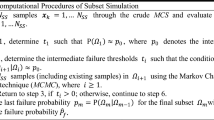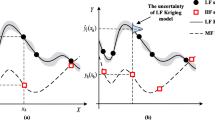Abstract
Simulation of multivariate cross-correlated random field samples (RFSs) is often required in reliability analysis of engineering structures. Conventional parametric methods for cross-correlated RFSs simulation generally require extensive measurements to obtain reliable random field parameters (e.g., type of auto-correlation function, correlation length, and cross-correlation matrix), for characterizing both the auto-correlation and cross-correlation structures among various cross-correlated engineering quantities. However, measurement data available in practice is often limited due to time, budget, technical and/or access constraints. Therefore, it is difficult to provide an accurate estimation of random field parameters (e.g., auto-correlation and cross-correlation matrix), rendering a challenging question of how to properly simulate multivariate cross-correlated RFSs from sparse measurements, especially when the number of engineering quantities of interest is large. This study aims to address this difficulty by developing a novel cross-correlated random field generator based on Bayesian compressive sensing (BCS) and Markov chain Monte Carlo (MCMC) simulation. The proposed method is data-driven and non-parametric, and it directly uses sparse measurements as input and provides cross-correlated RFSs as output. More importantly, the proposed method is able to deal with a large number of cross-correlated quantities for big data analytics in a high-dimension domain.





















Similar content being viewed by others
Reference
Aladejare A, Wang Y (2018) Influence of rock property correlation on reliability analysis of rock slope stability: from property characterization to reliability analysis. Geosci Front 9(6):1639–1648
Alamanis N, Dakoulas P (2021) Simulation of random fields of soil properties by the local average subdivision method and engineering applications. Energy Syst 12:841–861
Ang AH-S, Tang WH (2007) Probability concepts in engineering: emphasis on applications to civil and environmental engineering. Wiley, New York
Anh V, Broadbridge P, Olenko A, Wang Y (2018) On approximation for fractional stochastic partial differential equations on the sphere. Stoch Environ Res Risk Assess 32:2585–2603
Apanasovich T, Genton M (2010) Cross-covariance functions for multivariate random fields based on latent dimensions. Biometrika 97:15–30
Arroyo D, Emery X (2017) Spectral simulation of vector random fields with stationary Gaussian increments in d-dimensional Euclidean spaces. Stoch Environ Res Risk Assess 31:1583–1592
Au SK, WangY (2014) Engineering risk assessment with subset simulation. Wiley, Singapore, Pte. Ltd
Baecher G, Christian J (2003) Reliability and statistics in geotechnical engineering. Wiley, Chichester, pp 228–239
Baxevani A, Lenzi A (2018) Very short-term spatio-temporal wind power prediction using a censored Gaussian field. Stoch Environ Res Risk Assess 32:931–948
Bishop CM (2006) Pattern recognition and machine learning. Springer
Candès E, Wakin M (2008) An introduction to compressive sampling. IEEE Signal Process Mag 25(2):21–30
Candès E, Romberg J, Tao T (2006) Stable signal recovery from incomplete and inaccurate measurements. Commun Pure Appl Math 8:1207–1223
Ching J, Wu S, Phoon K (2016) Statistical characterization of random field parameters using frequentist and Bayesian approaches. Can Geotech J 53(2):285–298
Cho S (2010) Probabilistic assessment of slope stability that considers the spatial variability of soil properties. J Geotech Geoenviron Eng 136(7):975–984
Cho S, Park H (2010) Effect of spatial variability of cross correlated soil properties on bearing capacity of strip footing. Int J Numer Anal Methods Geomech 34(1):1–26
Cox D, Hinkley D (1974) Theoretical statistics. Springer, US, Boston, MA
Dai H, Zhang R, Beer M (2022) A new perspective on the simulation of cross-correlated random fields. Struct Saf 96:102201
Emery X, Arroyo D, Porcu E (2016) An improved spectral turning-bands algorithm for simulating stationary vector Gaussian random fields. Stoch Environ Res Risk Assess 30:1863–1873
Famili A, Shen W, Weber R, Simoudis E (1997) Data preprocessing and intelligent data analysis. Intell Data Anal 1(1–4):3–23
Fenton G, Vanmarcke E (1990) Simulation of random fields via local average subdivision. J Eng Mech 116(8):1733–1749
García S, Luengo J, Herrera F (2016) Tutorial on practical tips of the most influential data preprocessing algorithms in data mining. Knowledge-Based Syst 98:1–29
Grigoriu M (1993) On the spectral representation method in simulation. Probab Eng Mech 8(2):75–90
Guan Z, Wang Y (2021) Non-parametric construction of site-specific non-Gaussian multivariate joint probability distribution from sparse measurements. Struct Saf 91:102077
Guan Z, Wang Y, Zhao T (2022) Adaptive sampling strategy for characterizing spatial distribution of soil liquefaction potential using cone penetration test. J Rock Mech Geotech Eng 14(4):1221–1231
Hu Y, Zhao T, Wang Y, Choi C, Ng C (2019) Direct simulation of two-dimensional isotropic or anisotropic random field from sparse measurement using Bayesian compressive sampling. Stoch Environ Res Risk Assess 33:1477–1496
Jaksa MB (1995) The influence of spatial variability on the geotechnical design properties of a stiff, overconsolidated clay. University of Adelaide
Ji S, Xue Y, Carin L (2008) Bayesian compressive sensing. IEEE Trans Signal Process 56(2008):2346–2356
Ji S, Dunson D, Carin L (2009) Multitask compressive sensing. IEEE Trans Signal Process 57(1):92–106
Jiang S, Li D, Zhang L, Zhou C (2014) Slope reliability analysis considering spatially variable shear strength parameters using a non-intrusive stochastic finite element method. Eng Geol 168:120–128
Jiang S, Li D, Cao Z, Zhou C, Phoon K (2015) Efficient system reliability analysis of slope stability in spatially variable soils using Monte Carlo simulation. J Geotech Geoenviron Eng 141(2):04014096
Jiang Y, Hui Y, Wang Y, Peng L, Huang G, Liu S (2023) A novel eigenvalue-based iterative simulation method for multi-dimensional homogeneous non-Gaussian stochastic vector fields. Struct Saf 100:102290
Lenzi A, Pinson P, Clemmensen L, Guillot G (2017) Spatial models for probabilistic prediction of wind power with application to annual-average and high temporal resolution data. Stochast Environ Res Risk Assess 31:1615–1631
Li P, Wang Y (2021) Development of an efficient response surface method for highly nonlinear systems from sparse sampling data using Bayesian Compressive Sensing. ASCE-ASME J Risk Uncertain Eng Syst A Civil Eng 7(4):04021050
Liu L, Cheng Y, Zhang S (2017) Conditional random field reliability analysis of a cohesion-frictional slope. Comput Geotech 82:173–186
Lloret-Cabot M, Fenton G, Hicks M (2014) On the estimation of scale of fluctuation in geostatistics. Georisk: Assessment and Management of Risk for Engineered Systems and Geohazards, 8 (2): 129–140
Machado M, Adhikari S, Santos J (2017) A spectral approach for damage quantification in stochastic dynamic systems. Mech Syst Signal Process 88:253–273
Matheron G (1971) The theory of regionalized variables and its applications. Ecole Nationale Supérieure des Mines de Paris
Montoya-Noguera S, Zhao T, Hu Y, Wang Y, Phoon K (2019) Simulation of nonstationary non-Gaussian random fields from sparse measurements using Bayesian compressive sampling and Karhunen-Loève expansion. Struct Saf 79:66–79
Paola M, Gullo I (2001) Digital generation of multivariate wind field processes. Probab Eng Mech 16:1–10
Pati Y, Rezaiifar R, Krishnaprasad P (1993) Orthogonal matching pursuit: recursive function approximation with applications to wavelet decomposition. In: Proceedings of 27th Asilomar conference on signals systems and computers, Pacific Grove, Calif. IEEE, New York, pp. 40–44
Phoon K, Huang S, Quek S (2002) Implementation of Karhunen-Loève expansion for simulation using a wavelet-Galerkin scheme. Probab Eng Mech 17(3):293–303
Phoon K, Huang H, Quek S (2005) Simulation of strongly non-Gaussian processes using Karhunen-Loève expansion. Probab Eng Mech 20(2):188–198
Ribeiro A, Junior P, Bonat W (2022) A Kronecker-based covariance specification for spatially continuous multivariate data. Stoch Environ Res Risk Assess 36:4087–4102
Robin M, Gutjahr A, Sudicky E, Wilson J (1993) Cross-correlated random field generation with the direct Fourier transform method. Water Resour Res 29:2385–2397
Shinozuka M, Deodatis G (1991) Simulation of stochastic processes by spectral representation. Appl Mech Revi 44(4):191–204
Sivia DS, Skilling J (2006) Data analysis: a Bayesian tutorial. Oxford University Press, New York
Smith M, Eddins S (1990) Analysis/synthesis techniques for subband image coding. IEEE Trans Acoust Speech Signal Process 38(8):1446–1456
Tang X, Wang M, Li D (2020) Modeling multivariate cross-correlated geotechnical random fields using vine copulas for slope reliability analysis. Comput Geotech 127:103784
Tipping M (2001) Sparse Bayesian learning and the relevance vector machine. J Mach Learn Res 1:211–244
Torquato S (2013) Random heterogeneous materials: microstructure and macroscopic properties. Springer Science & Business Media, New York
Tropp J, Gilbert A (2007) Signal recovery from random measurements via orthogonal matching pursuit. IEEE Trans Inf Theory 53(12):4655–4666
Uzielli M, Vannucchi G, Phoon K (2005) Random field characterisation of stress-normalised cone penetration testing parameters. Geotechnique 55(1):3–20
Vořechovský M (2008) Simulation of simply cross correlated random fields by series expansion methods. Struct Saf 30:337–363
Wang Y, Li P (2021) Data-driven determination of sample number and efficient sampling locations for geotechnical site investigation of a cross-section using Voronoi diagram and Bayesian compressive sampling. Comput Geotech 130(2021):103898
Wang Y, Zhao T (2016) Interpretation of soil property profile from limited measurement data: a compressive sampling perspective. Can Geotech J 53(9):1547–1559
Wang Y, Zhao T (2017) Statistical interpretation of soil property profiles from sparse data using Bayesian compressive sampling. Géotechnique 67(6):523–536
Wang Y, Akeju O, Zhao T (2017) Interpolation of spatially varying but sparsely measured geo-data: a comparative study. Eng Geol 231:200–217
Wang Y, Zhao T, Phoon K (2018) Direct simulation of random field samples from sparsely measured geotechnical data with consideration of uncertainty in interpretation. Can Geotechnical Journal 55(6):862–880
Wang M, Tang X, Li D, Qi X (2020) Subset simulation for efficient slope reliability analysis involving copula-based cross-correlated random fields. Comput Geotech 118:103326
Wang Y, Hu Y, Phoon K (2022) Non-parametric modelling and simulation of spatiotemporally varying geo-data. Georisk: Assessment and Management of Risk for Engineered Systems and Geohazards, 16 (1): 77–97
Webster R, Oliver M (2007) Geostatistics for environmental scientists. Wiley, Hoboken
Wu S, Law S (2012) Evaluating the response statistics of an uncertain bridge-vehicle system. Mech Syst Signal Process 27:576–589
Yamazaki F, Shinozuka M (1990) Simulation of stochastic fields by statistical preconditioning. J Eng Mech 116:268–287
Yang Z, Li X, Qi X (2022) Efficient simulation of multivariate three-dimensional cross-correlated random fields conditioning on non-lattice measurement data. Comput Methods Appl Mech Eng 388:114208
Zhao T, Wang Y (2018) Interpretation of pile lateral response from deflection measurement data: a compressive sampling-based method. Soils Found 58(4):957–71
Zhao T, Wang Y (2018) Simulation of cross-correlated random field samples from sparse measurements using Bayesian compressive sensing. Mech Syst Signal Process 112:384–400
Zhao T, Wang Y (2020) Non-parametric simulation of non-stationary non-Gaussian 3D random field samples directly from sparse measurements using signal decomposition and Markov Chain Monte Carlo (MCMC) simulation. Reliab Eng Syst Saf 203:107087
Zhu H, Zhang L, Xiao T, Li X (2017) Generation of multivariate cross-correlated geotechnical random fields. Comput Geotech 86:95–107
Funding
The work described in this paper was supported by a grant from the Research Grant Council of Hong Kong Special Administrative Region (Project no. CityU 11203322), a grant from the Innovation and Technology Commission of Hong Kong Special Administrative region (Project no: MHP/099/21), and a grant from Shenzhen Science and Technology Innovation Commission (Shenzhen-Hong Kong-Macau Science and Technology Project (Category C) No: SGDX20210823104002020), China. The financial support is gratefully acknowledged.
Author information
Authors and Affiliations
Contributions
Peiping Li and Yu Wang wrote the main manuscript text and developed all figures and tables. Zheng Guan contributed the implementation of treating cross-correlation as auto-correlation and data preprocessing.
Corresponding author
Ethics declarations
Conflict of interest
The authors declare that they have no known competing financial interests or personal relationships that could have appeared to influence the work reported in this paper.
Additional information
Publisher's Note
Springer Nature remains neutral with regard to jurisdictional claims in published maps and institutional affiliations.
Rights and permissions
Springer Nature or its licensor (e.g. a society or other partner) holds exclusive rights to this article under a publishing agreement with the author(s) or other rightsholder(s); author self-archiving of the accepted manuscript version of this article is solely governed by the terms of such publishing agreement and applicable law.
About this article
Cite this article
Li, P., Wang, Y. & Guan, Z. Non-parametric generation of multivariate cross-correlated random fields directly from sparse measurements using Bayesian compressive sensing and Markov chain Monte Carlo simulation. Stoch Environ Res Risk Assess 37, 4607–4628 (2023). https://doi.org/10.1007/s00477-023-02523-z
Accepted:
Published:
Issue Date:
DOI: https://doi.org/10.1007/s00477-023-02523-z




